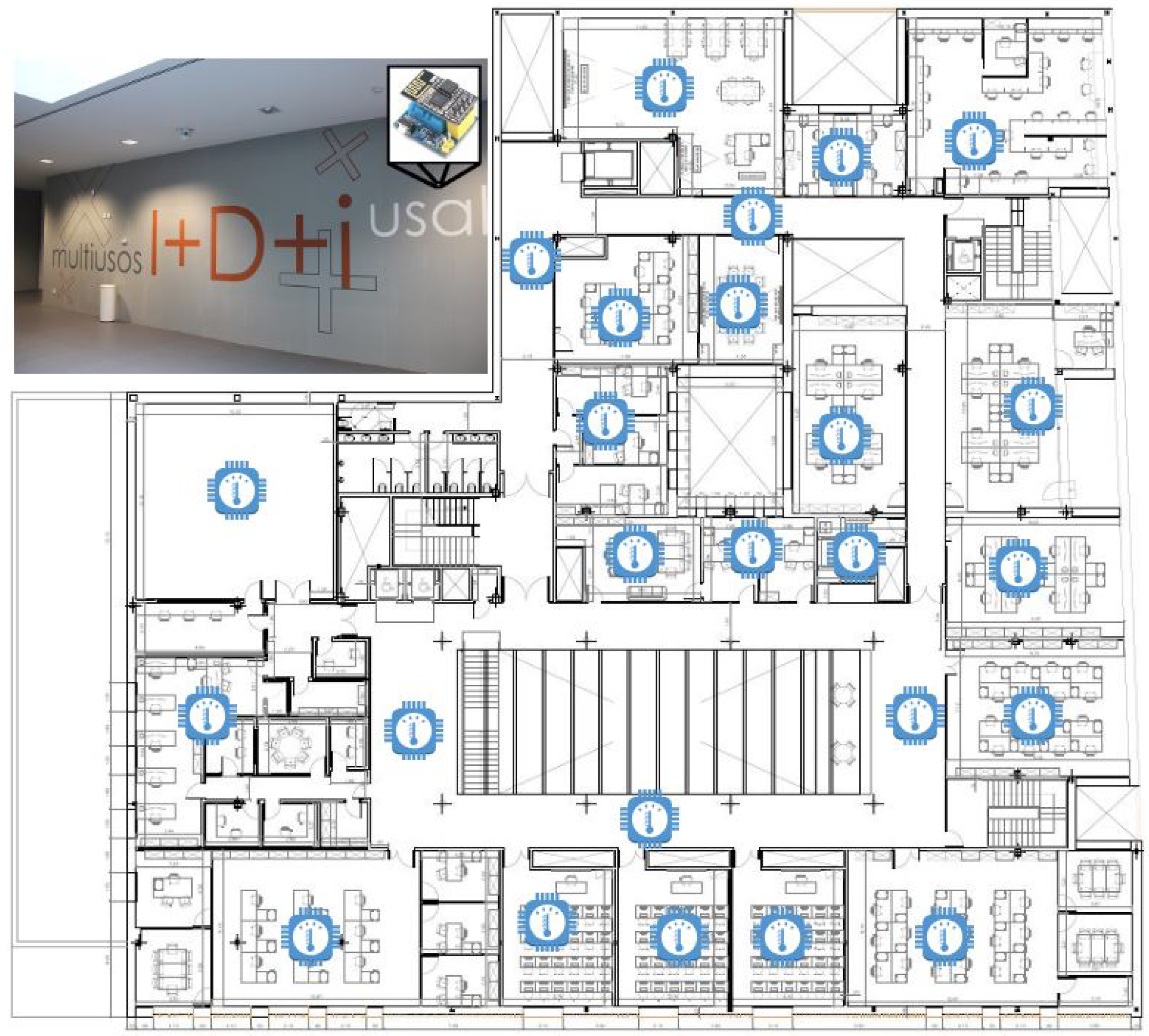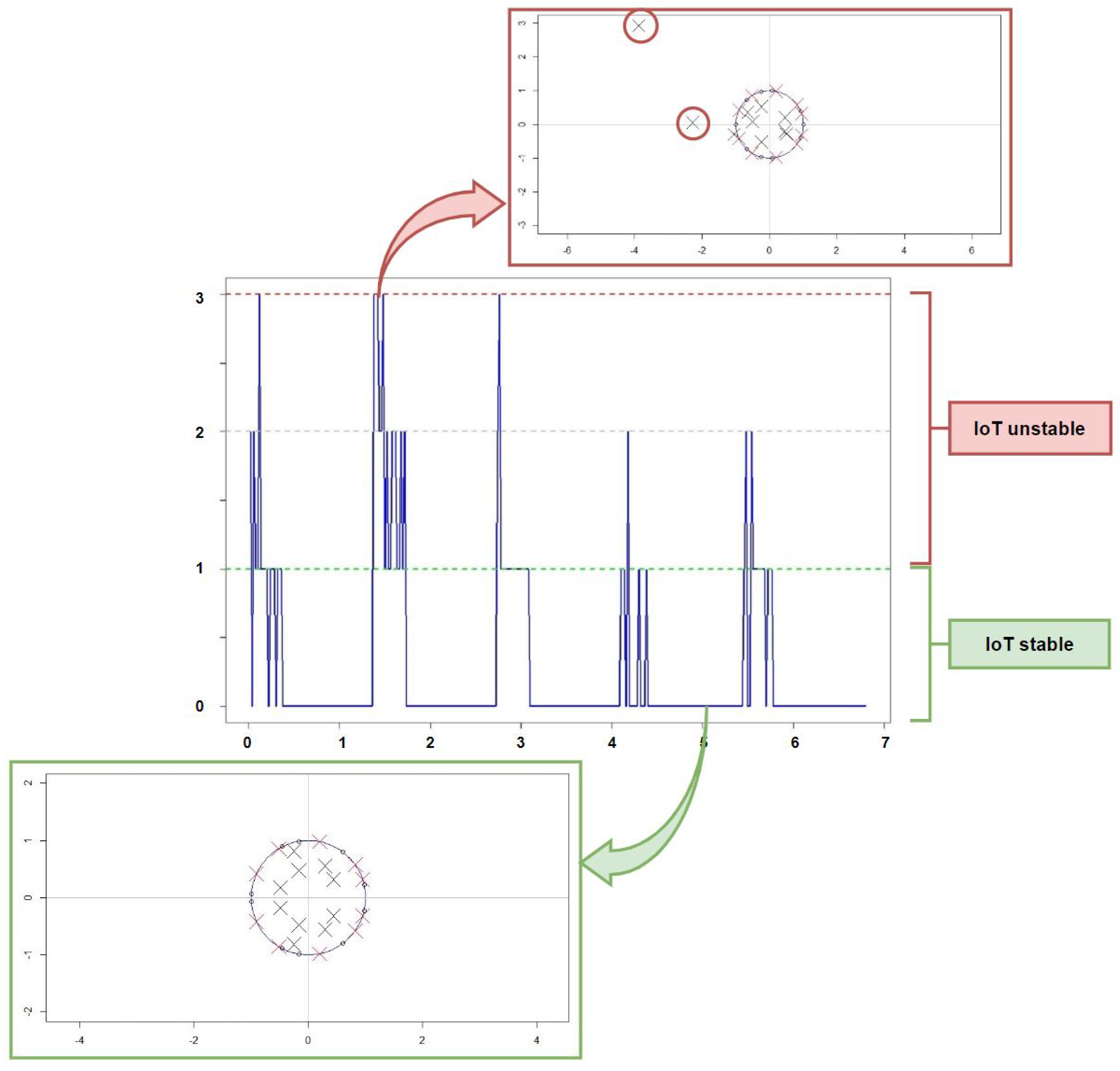A New Stability Criterion for IoT Systems in Smart Buildings: Temperature Case Study
Abstract
1. Introduction
- is a diagonalizable matrix.
- is the non-singular eigenvector matrix such that , where is a diagonal matrix.
- If is invertible, its condition number in p-norm is denoted by and defined by:
- To the best of our knowledge, the proposed novel approach allows obtaining a mathematical model of the IoT system based on graph theory.
- A new Laplacian IoT matrix has been created from the network associated with the IoT system. This new matrix has allowed the authors to apply the Spectral Graph Theory to obtain useful information from the IoT system and thus improve its operation.
- A new IoT stability criterion for IoT systems based on the Spectral Graph Theory that increases the efficiency of IoT control systems since the IoT stability criterion does not involve the transfer function of the control algorithm.
2. Basic Definition and Notation of Laplacian IoT Matrix
3. The IoT Matrix Spectrum
3.1. Eigenvalue Properties
3.2. Eigenvalue Location
4. Stability Criterion in a Perturbed IoT System
IoT Stability Criterion
| Algorithm 1 IoT stability detection algorithm |
|
5. Numerical Case Study
5.1. General Description of the Case Study
5.2. Case Study Results and Discussions
6. Conclusions
Author Contributions
Funding
Acknowledgments
Conflicts of Interest
References
- Lee, I.; Lee, K. The Internet of Things (IoT): Applications, investments, and challenges for enterprises. Bus. Horizons 2015, 58, 431–440. [Google Scholar] [CrossRef]
- Casado-Vara, R.; Chamoso, P.; De la Prieta, F.; Prieto, J.; Corchado, J.M. Non-linear adaptive closed-loop control system for improved efficiency in IoT-blockchain management. Inf. Fusion 2019, 49, 227–239. [Google Scholar] [CrossRef]
- Lim, C.; Maglio, P.P. Data-driven understanding of smart service systems through text mining. Serv. Sci. 2018, 10, 154–180. [Google Scholar] [CrossRef]
- Krejcar, O.; Maresova, P.; Selamat, A.; Melero, F.J.; Barakovic, S.; Husic, J.B.; Herrera-Viedma, E.; Frischer, R.; Kuca, K. Smart Furniture as a Component of a Smart City—Definition Based on Key Technologies Specification. IEEE Access 2019, 7, 94822–94839. [Google Scholar] [CrossRef]
- Parra, L.; Rocher, J.; Sendra, S.; Lloret, J. An Energy-Efficient IoT Group-Based Architecture for Smart Cities. In Energy Conservation for IoT Devices; Springer: Singapore, 2019; pp. 111–127. [Google Scholar]
- Liu, Y.; Yang, C.; Jiang, L.; Xie, S.; Zhang, Y. Intelligent edge computing for IoT-based energy management in smart cities. IEEE Netw. 2019, 33, 111–117. [Google Scholar] [CrossRef]
- Tu, Y. Distribution Network Operation Control Algorithm for Distributed Data Quality Management System. Int. J. Perform. Eng. 2020, 16, 766–774. [Google Scholar]
- Wang, J.; Chang, N.C.P.; Feng, X.; Monti, A. Design of a generalized control algorithm for parallel inverters for smooth microgrid transition operation. IEEE Trans. Ind. Electron. 2015, 62, 4900–4914. [Google Scholar] [CrossRef]
- Plageras, A.P.; Psannis, K.E.; Stergiou, C.; Wang, H.; Gupta, B.B. Efficient IoT-based sensor BIG Data collection—Processing and analysis in smart buildings. Future Gener. Comput. Syst. 2018, 82, 349–357. [Google Scholar] [CrossRef]
- Minoli, D.; Sohraby, K.; Occhiogrosso, B. IoT considerations, requirements, and architectures for smart buildings—Energy optimization and next-generation building management systems. IEEE Internet Things J. 2017, 4, 269–283. [Google Scholar] [CrossRef]
- Bianchini, G.; Casini, M.; Vicino, A.; Zarrilli, D. Demand-response in building heating systems: A Model Predictive Control approach. Appl. Energy 2016, 168, 159–170. [Google Scholar] [CrossRef]
- Javed, A.; Larijani, H.; Ahmadinia, A.; Emmanuel, R.; Mannion, M.; Gibson, D. Design and implementation of a cloud enabled random neural network-based decentralized smart controller with intelligent sensor nodes for HVAC. IEEE Internet Things J. 2016, 4, 393–403. [Google Scholar] [CrossRef]
- Grigsby, L.L. Power System Stability and Control; CRC Press: Boca Raton, FL, USA, 2016. [Google Scholar]
- Biggs, N.; Biggs, N.L.; Norman, B. Algebraic Graph Theory; Cambridge University Press: Cambridge, UK, 1993; Volume 67. [Google Scholar]
- Cvetkovic, D.M.; Doob, M.; Sachs, H. Spectra of Graphs; Academic Press: New York, NY, USA, 1980; Volume 10. [Google Scholar]
- Trinajstic, N. Chemical Graph Theory; Routledge: London, UK, 2018. [Google Scholar]
- Ortega, A.; Frossard, P.; Kovačević, J.; Moura, J.M.; Vandergheynst, P. Graph signal processing: Overview, challenges, and applications. Proc. IEEE 2018, 106, 808–828. [Google Scholar] [CrossRef]
- Gao, W.; Wu, H.; Siddiqui, M.K.; Baig, A.Q. Study of biological networks using graph theory. Saudi J. Biol. Sci. 2018, 25, 1212–1219. [Google Scholar] [CrossRef] [PubMed]
- Wang, J.L.; Adhikari, G.; Kobayashi, H.; Tsukiji, N.; Hirano, M.; Kurihara, K.; Nagahama, A.; Noda, I.; Yoshii, K. Analysis and Design of Operational Amplifier Stability Using Routh-Hurwitz Stability Criterion. In Applied Mechanics and Materials; Trans Tech Publications: Warwick, NY, USA, 2019; Volume 888, pp. 1–10. [Google Scholar]
- Ng, Y.X.; Phang, C. Computation of Stability Criterion for Fractional Shimizu–Morioka System Using Optimal Routh—Hurwitz Conditions. Computation 2019, 7, 23. [Google Scholar] [CrossRef]
- Zhang, Y.; Qi, Z.; Yang, M.; Guo, J.; Huang, H. Step-width theoretics and numerics of four-point general DTZN model for future minimization using Jury stability criterion. Neurocomputing 2019, 357, 231–239. [Google Scholar] [CrossRef]
- Proskurnikov, A.V.; Matveev, A.S. Tsypkin and Jury—Lee criteria for synchronization and stability of discrete-time multiagent systems. Autom. Remote Control 2018, 79, 1057–1073. [Google Scholar] [CrossRef]
- Nguyen, T.S.; Likitlersuang, S.; Jotisankasa, A. Influence of the spatial variability of the root cohesion on a slope-scale stability model: A case study of residual soil slope in Thailand. Bull. Eng. Geol. Environ. 2019, 78, 3337–3351. [Google Scholar] [CrossRef]
- Lumbreras, D.; Barrios, E.L.; Urtasun, A.; Ursua, A.; Marroyo, L.; Sanchis, P. On the Stability of Advanced Power Electronic Converters: The Generalized Bode Criterion. IEEE Trans. Power Electron. 2018, 34, 9247–9262. [Google Scholar] [CrossRef]
- Kao, C.Y.; Lincoln, B. Simple stability criteria for systems with time-varying delays. Automatica 2004, 40, 1429–1434. [Google Scholar] [CrossRef]
- Homod, R.Z. Analysis and optimization of HVAC control systems based on energy and performance considerations for smart buildings. Renew. Energy 2018, 126, 49–64. [Google Scholar] [CrossRef]
- Casado-Vara, R.; Martin-del, R.A.; Affes, S.; Prieto, J.; Corchado, J.M. IoT network slicing on virtual layers of homogeneous data for improved algorithm operation in smart buildings. Future Gener. Comput. Syst. 2020, 102, 965–977. [Google Scholar] [CrossRef]
- Casado-Vara, R.; Prieto-Castrillo, F.; Corchado, J.M. A game theory approach for cooperative control to improve data quality and false data detection in WSN. Int. J. Robust Nonlinear Control 2018, 28, 5087–5102. [Google Scholar] [CrossRef]
- Killian, M.; Zauner, M.; Kozek, M. Comprehensive smart home energy management system using mixed-integer quadratic-programming. Appl. Energy 2018, 222, 662–672. [Google Scholar] [CrossRef]
- Casado-Vara, R.; Vale, Z.; Prieto, J.; Corchado, J. Fault-tolerant temperature control algorithm for IoT networks in smart buildings. Energies 2018, 11, 3430. [Google Scholar] [CrossRef]
- Casado-Vara, R.; Novais, P.; Gil, A.B.; Prieto, J.; Corchado, J.M. Distributed continuous-time fault estimation control for multiple devices in IoT networks. IEEE Access 2019, 7, 11972–11984. [Google Scholar] [CrossRef]
- Franklin, J.N. Matrix Theory; Courier Corporation: North Chelmsford, MA, USA, 2012. [Google Scholar]
- Hau, N.H.; Tinh, T.T.; Tuong, H.A.; Wong, W.K. Review of Matrix Theory with Applications in Education and Decision Sciences. Adv. Decis. Sci. 2020, 24, 28–69. [Google Scholar]
- Bauer, F.L. Fields of values and Gershgorin disks. Numer. Math. 1968, 12, 91–95. [Google Scholar] [CrossRef]
- Curran, P.F. On a Variation of the Gershgorin Circle Theorem with Applications to Stability Theory; IET: Dublin, Ireland, 2009. [Google Scholar]
- Stewart, G.W. Gershgorin theory for the generalized eigenvalue problem Ax = λBx. Math. Comput. 1975, 29, 600–606. [Google Scholar] [CrossRef]
- Greenbaum, A.; Li, R.C.; Overton, M.L. First-order perturbation theory for eigenvalues and eigenvectors. SIAM Rev. 2020, 62, 463–482. [Google Scholar] [CrossRef]
- Bauer, F.L.; Fike, C.T. Norms and exclusion theorems. Numer. Math. 1960, 2, 137–141. [Google Scholar] [CrossRef]
- Deif, A.S. Realistic a priori and a posteriori error bounds for computed eigenvalues. IMA J. Numer. Anal. 1990, 10, 323–329. [Google Scholar] [CrossRef]
- Finner, H. A generalization of Holder’s inequality and some probability inequalities. Ann. Probab. 1992, 20, 1893–1901. [Google Scholar] [CrossRef]



| Timestamp Start | Total Timestamp | Min Temp | Max Temp | Mean | Standard Deviation |
|---|---|---|---|---|---|
| 2020-06-17T09:00 | 06:00:00Z | 20.4 C | 24.7 C | 22.8 C | 0.87 C |
© 2020 by the authors. Licensee MDPI, Basel, Switzerland. This article is an open access article distributed under the terms and conditions of the Creative Commons Attribution (CC BY) license (http://creativecommons.org/licenses/by/4.0/).
Share and Cite
Casado-Vara, R.; Martín del Rey, A.; Alonso, R.S.; Trabelsi, S.; Corchado, J.M. A New Stability Criterion for IoT Systems in Smart Buildings: Temperature Case Study. Mathematics 2020, 8, 1412. https://doi.org/10.3390/math8091412
Casado-Vara R, Martín del Rey A, Alonso RS, Trabelsi S, Corchado JM. A New Stability Criterion for IoT Systems in Smart Buildings: Temperature Case Study. Mathematics. 2020; 8(9):1412. https://doi.org/10.3390/math8091412
Chicago/Turabian StyleCasado-Vara, Roberto, Angel Martín del Rey, Ricardo S. Alonso, Saber Trabelsi, and Juan M. Corchado. 2020. "A New Stability Criterion for IoT Systems in Smart Buildings: Temperature Case Study" Mathematics 8, no. 9: 1412. https://doi.org/10.3390/math8091412
APA StyleCasado-Vara, R., Martín del Rey, A., Alonso, R. S., Trabelsi, S., & Corchado, J. M. (2020). A New Stability Criterion for IoT Systems in Smart Buildings: Temperature Case Study. Mathematics, 8(9), 1412. https://doi.org/10.3390/math8091412









